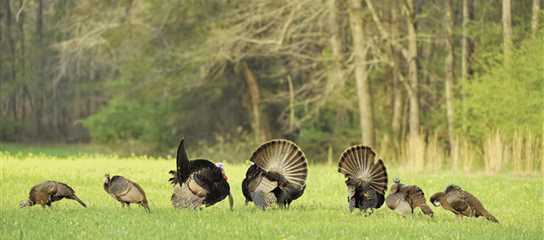Turkey hunting is a great challenge that many hunters in America enjoy. Knowing these incredible birds and their habits can make all the difference in your success. Turkeys live in specific areas called home ranges. When young turkeys, known as poults, first hatch, they stay in a small area, within about 100 acres. As they grow, their mother leads them to find food, water, and shelter, helping them get familiar with the land.
By the time they are old enough to breed, turkeys usually stick to the area where they were raised. They often breed, nest, and raise their young in the same place. For hunters, understanding this behavior can help when planning a hunting trip. Providing what turkeys need in their environment (food, water, and shelter) might increase your chances of seeing them.
We will share some practical turkey hunting tips to help you understand turkey behavior, pick the right gear, get the hang of calling techniques, and choose the best hunting spot. If you are new to turkey hunting or just want to improve your skills, these pointers can help you make the most of this turkey hunting season.
Getting to Know Turkey Behavior
-
Turkeys’ Sharp Eyesight
Wild turkeys have amazing eyesight, much better than ours. They can spot even the smallest movements from far away. Since their eyes are on the sides of their head, they can see almost all around them. For hunters, it is really important to stay still and blend into the surroundings. Wearing camouflage and moving as little as possible can help you avoid being spotted by these alert birds.
-
Morning Roosting Patterns
Turkeys sleep in trees at night to keep them safe from predators. At sunrise, they fly down to start their day. This makes early morning a great time for a hunt. If you listen for gobbling sounds at first light, you might find a roosted gobbler. Setting up near these spots can boost your chances of seeing turkeys as they begin their daily routine.
-
Feeding Habits
Turkeys spend a lot of time during the day looking for food. They eat seeds, insects, and berries, often moving through fields and woods. Knowing where they like to feed can help you pick a good hunting spot. Places like agricultural fields and field edges are good areas to watch for feeding turkeys. Scouting these spots might reveal patterns in how turkeys move around.
-
Traveling Patterns
Turkeys often use the same paths when they move between where they sleep, eat, and drink. They like routes that give them some cover from predators. If you can figure out these travel paths, you can set them up. This can boost your chances of running into turkeys as they go about their day.
Essential Gear for Turkey Hunting Success
-
Camouflage Clothing
Blending into the surroundings is vital when hunting turkeys. Wearing camouflage that matches the area helps you stay hidden from their keen eyes. Pick patterns that look like the local plants, and remember to cover your hands and face too. This way, you lower the odds that they will notice you due to some skin or clothing elements that contrast with the surrounding area.
-
Shotgun and Ammunition
Choosing the right shotgun and ammo makes a big difference. Many turkey hunters use a 12-gauge shotgun. Using shells made for turkey hunting helps you get the right shot placement. We recommend practicing with your gun before the season starts to improve your accuracy and confidence when you are out there.
-
Decoys and Calls
Calls and decoys can bring turkeys closer. Gobblers can be attracted by decoys such as hen or Jake models. Box calls are simple to use and can sound like turkey calls. You can try out different types to see what works where you are hunting. The better you get with these tools, the more your chances of a successful hunt increase.
-
Ground Blinds
A ground blind helps you stay hidden and allows you to move a bit without being seen. It is really helpful if you are hunting with beginners or on public land where you might have more cautious turkeys because of hunting pressure. For a comfortable, effective hunting spot, place the blind near the edge of a field or path that turkeys use.
-
Choke Tubes and Accessories
A choke tube can be a highly effective accessory. It improves accuracy for longer shots by constricting the bore of the shotgun barrel, which tightens the shot pattern as the pellets exit the barrel. Additionally, the choke helps achieve a more ethical and effective kill by ensuring that the shot is concentrated in a small, critical area.
Mastering Turkey Calls and Decoys
-
Different Types of Calls
Different kinds of turkey calls imitate various turkey sounds. Trying out these different calls helps you find what works best for you and your hunting area. Some common ones are:
- Box Calls: Simple to use and suitable for making loud yelps and clucks.
- Diaphragm Calls: Mouth calls that let you keep your hands free.
- Slate Calls: A slate surface and a striker create soft, subtle calls.
-
Using Calls Effectively
With calls, timing and sounding real are important. Start with soft clucks and purrs to see how the turkey responds. If a gobbler answers, try to match its intensity but don’t call too much. Watch how turkeys react, be patient, and adjust your call strategy as needed.
-
Setting Up Decoys
Setting up decoys can help bring turkeys into range if you do it right. Place a hen decoy in an open spot where it can be seen from far away. Putting a Jake decoy nearby might attract a dominant tom. Watch your surroundings and make sure the decoys look natural. Good calls in addition to well-placed decoys can help increase your chances of success.
Choosing the Perfect Hunting Spot
-
Scouting the Area
Good hunting starts with knowing the area. Look for signs of turkeys like tracks, droppings, and feathers. Listen for gobbling sounds early in the morning or the evening. If you are hunting close to home or exploring some of the best turkey hunting states, scouting is key. Checking out the area before the season can show you where turkeys feed and move. The prep work helps you pick a good hunting spot.
-
Roosting Areas
Turkeys sleep in trees at night, and finding where they roost can help. Look for big trees with lots of branches where turkeys might perch. Before dawn, setting yourself up near these spots can help your chances during a morning hunt. When scouting, be careful not to scare them because turkeys might leave a roost if they feel threatened.
-
Using Natural Cover
Natural cover such as trees and bushes help you hide. They can break up your outline and keep you hidden. Do not set up in open areas where turkeys can see you easily. Instead, blend in with the surroundings and make sure you can see the turkeys’ paths. It is important for a successful hunt to balance hiding and having a good view.
Best Times and Seasons for Turkey Hunting
-
Spring vs. Fall Hunting
Spring hunting is typically more popular because it coincides with the breeding season. Male turkeys are more active and vocal, making them easier to locate and more likely to respond to calls. Fall hunters often rely more on tactics that require finding flocks and knowing their feeding habits, since turkeys are more spread out and less responsive to calls.
-
Morning vs. Afternoon Hunts
Hunting in the morning can be good since turkeys are just starting their day. If you set up before sunrise, you might catch them as they come down from their roost. Afternoon hunts can be more challenging, as turkeys tend to be less vocal and more scattered. Later in the day, focus on food or water sources where turkeys may gather. Changing your plan based on the time of day can help you make the most of your hunting opportunities.
-
Weather Considerations
The weather affects how turkeys behave. They might be less active when it is raining or very windy because it makes it harder for them to hear and see predators. Cooler mornings might keep them in the roost longer. Keeping an eye on the weather and adjusting your plans accordingly will improve your hunting trip.
Approaching Turkeys and Staying Stealthy
-
Minimizing Movement
Turkeys notice even the smallest movement, so staying still is key. Move slowly and only when the turkey’s head is turned away or behind something. Think about your movements ahead of time to avoid extra motion. Even small things like shifting your weight or adjusting your grip can alert them. Practice sitting still for long periods of time to prepare for the hunt.
-
Using Cover
Use what is around you to stay hidden. Sit against a big tree or in thick bushes that break up your outline. Wear camouflage that matches the area, including gloves and a face mask. By blending in, you lower the chances of turkeys spotting you.
-
Staying Patient
Being patient is critical in turkey hunting. Sometimes it is best to wait quietly and let the turkey come to you. Try not to call too much or move around a lot. Trust your setup and give the turkey time to respond. Staying calm can often lead to better outcomes.
Shooting and Safety Tips
- Make sure your target is within range and know what is behind it before you shoot.
- For an ethical kill, aim for the turkey’s most vital spots, the head or neck.
- To improve accuracy, rest your gun on something steady.
- Wear orange so other hunters can see you.
- Until you are ready to shoot, keep your gun’s safety on.
Handling Common Challenges
- Nervous Turkeys: If the birds are jumpy, change how you call or use fewer decoys.
- Bad Weather: Adjust your plan based on the weather. In rainy or windy conditions, look for sheltered spots where turkeys might be.
- Gear Challenges: Be sure your gear is comfortable and appropriate for the weather. Ensure your hunting equipment and accessories are in good condition.
- Crowded Areas: If you are hunting on public land, try to go during the week or off-peak times to avoid the crowds.
- Getting Tired: Turkey hunting can take a lot of time. Make sure to drink water and take breaks to stay sharp.
Benefits of Hunting on Private or Leased Land
One of the benefits of hunting on private land is less competition and the ability to manage the land in order to improve hunting opportunities. It is important to build a good relationship with landowners. Ask for permission, be polite, and be clear about what you are doing. Helping out or sharing some of your harvest can be a great offer.
If you are interested in having regular access or managing your own hunting spot, you might want to look into land for sale. Owning or leasing hunting land lets you create the perfect environment for turkeys, increasing your chances of a successful hunt. Investing in your own property can enrich your experience as an outdoor enthusiast and provide hunting opportunities for years to come.


